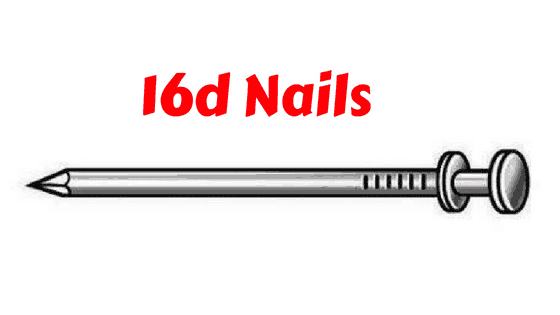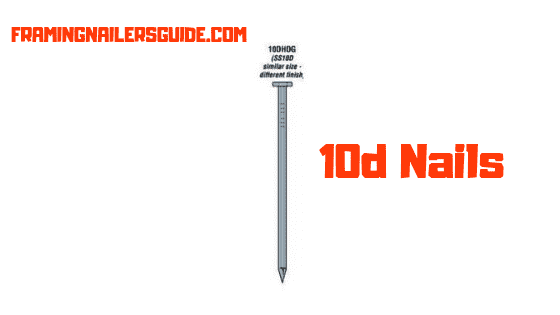Table of Contents
Last Updated on November 21, 2024 by John Patterson

Let’s start the Nail Sizing with a few questions.
What are the best nails for framing?
What nails are to be used for framing with a nail gun?
Before using the best nail gun, you must know what size nails you need for framing with a nail gun. Using the proper framing nails can save your work.
So choosing the right nail size for framing and understanding the types of framing nails are the first requirements for nailing because if you use a very long and fat one that can split wood.
Again if you use short nails instead of long nails, that may not do the job.
The nail parts depend on the relationship of the lumber parts.
Considering each aspect, you must choose the best size nails for framing.
So you need to select the correct nail sizes for framing to nail sizes for framing; you can’t complete your framing projects.
And for your benefit, I’m just talking about it to stay with me.
What Size Nails Do You Need For Framing?

Could you let us know what size nails are for framing?
Standard Nail sizes for framing with types-
Nail Size for Framing
Nail length Guide
There are dozens of different nail lengths.
The most common size nails for framing are – 16d nails, 10d nails, 8d nails, 6d nails, etc.
The sizes of pennies indicate nail lengths, as well as the diameters.
Along with nail lengths, you should know where to use these nails.
Building walls, roofs, and sub-flooring are some parts where size nails for framing are used, and you should select lengths to continue the job correctly.
In fastening sheathing, clapboard, etc., the length of the nail should be three times longer than the thickness.
Sometimes, long nails are helpful, but only occasionally. Sometimes, the longer ones can split suddenly when working.
16d Nail Length/Nail Size

When introducing 16d nails, the first to know is the types of 16d nails.
Generally, these are 3 ½ inches long.
For fastening framing materials like wall plates or rim joints, 16d is used.
You will find two types of 16d nails in any hardware store.
The types are common nails and sinkers.
The standard best nails have a smooth head, and sinkers have a textured authority.
A textured head can prevent hammers from slipping.
The diameter of common nails is 0.162 inches.
But a 0.148-inch diameter is the best choice for framing, which means sinkers are better when you will do the frame.
Sinkers can easily slide into the wood as these have vinyl or epoxy coating.
While you have to drive a lot of 16d nails, then it is an important consideration.
10d Nail Length/Nail Diameter/Nail Size
Many of the building plans, as well as truss drawings, specify 10d galvanized nails.
The length is 3 inches, and the diameter is 0.148 inches.
You cannot substitute lesser-diameter 3 inches of nails.
Install 10d nails so that no nail edge is less than ¾ inches.
For 10d nails, space should not be less than five times its diameter.
If two board faces are flat, it is appropriate to join using this nail.
Where floor joists overlap or double up studs, 10d nails are the best in this regard.
8d Nail Length/Nail Size
When you need to attach furring strips, subfloors, or other materials, which don’t need large nails, there you can use 8d nails.
These are 2.5 inches long, the diameter is .134 inches, and the head diameter is 9/32 inches.
There are 8d vinyl-coated sinkers which are slightly narrower than other common nails.
While it demands driving a nail at an angle to the end of a member, choose 8d nails.
For attaching studs to wall plates, rafters to wall top plates – these are the fields, you use 8d nails.
You will find 8d nails in any hardware store.
6d Nail Size/Nail Length/Nail Diameter

6d nails have two types: 6d common and 6d box nail.
The shank length is 2 inches, the shank diameter is 0.12 inches, and the head diameter is 17/64 inches.
As these have less diameter, these are not usually used ones.
For using in small interior works or joining flat woods, these nails are the best choice instead of other large pins.
These are safe to use in these cases because otherwise, the flat plate of wood can break into pieces.
So go with 6d nails in that case.
Metal anchors
For securing objects to your home walls, homeowners use decent metal anchors.
People use metal anchors for multipurpose purposes; these have many designs.
Metal anchor design types are simple sleeve to a toggle bolts, molly bolts, and bolt anchors.
Cement, wood, concrete block, and even drywalls are different fields where metal anchors can be used.
These are best for securing places for an arbor.
Also, roof rafters’ workings need metal anchors to install a handrail, and shelving units that are large.
For metal anchors, you need to consider the weight of the object and the type of material.
These are better for heavy shelves.
Nail measurement guide: 2d-16d
| Nail Size | Length (inches) | Diameter (inches) | Gauge |
|---|---|---|---|
| 2d | 1 | 0.072 | 15 |
| 3d | 1.25 | 0.083 | 14 |
| 4d | 1.5 | 0.109 | 12 |
| 5d | 1.75 | 0.109 | 12 |
| 6d | 2 | 0.113 | 11.5 |
| 8d | 2.5 | 0.131 | 10.25 |
| 10d | 3 | 0.148 | 9 |
| 12d | 3.25 | 0.148 | 9 |
| 16d | 3.5 | 0.162 | 8 |
When you need nails, they have to know the measurements of the pins.
2d – 1-inch shank length and 0.072 inches shank diameter.
3d – 1.25 inches shank length and 0.083 inches shank diameter.
4d – 1.5 inches shank length and 0.109 inches shank diameter.
5d – 1.75 inches shank length and 0.109 inches shank diameter.
6d – 2 inches shank length and 0.12 inches shank diameter.
8d – 2.5 inches shank length and 0.134 inches shank diameter.
10d – 3 inches shank length and 0.148 inches shank diameter.
12d – 3.25 inches shank length and 0.148 inches shank diameter.
Let’s watch the video to see the different types of framing nails
Frequently Asked Questions (FAQs)
Question #1: How to position the wire for hanging a massive picture?
Answer: Put a fork on your nail and put the picture on the wall. Then remove the knife.
Question #2: Why do nails bend while hammering into the stud?
Just answer: First, please consider the material which you are studying. Sometimes metal depending studs possibly need in place of wood. Wood studs may cause this to happen.
Question #3: What nails can you use for joist hangers?
Answer: 16d double-dipped galvanized nails are generally used for installing hangers.
Question #4: What size nails for 2×4 framing?
Answer: For 2×4 framing, the best is to use 3.5 inches nails or 16d nails.
Final Words
When working with various framing nails and nailers, it is necessary to know the nail size for framing.
This article tells you about multiple kinds of nail sizes for framing and their application.
So, it will be easy to choose framing nails for your work.
You won’t face the problem of breaking nails if you can select the correct size nails for framing.






